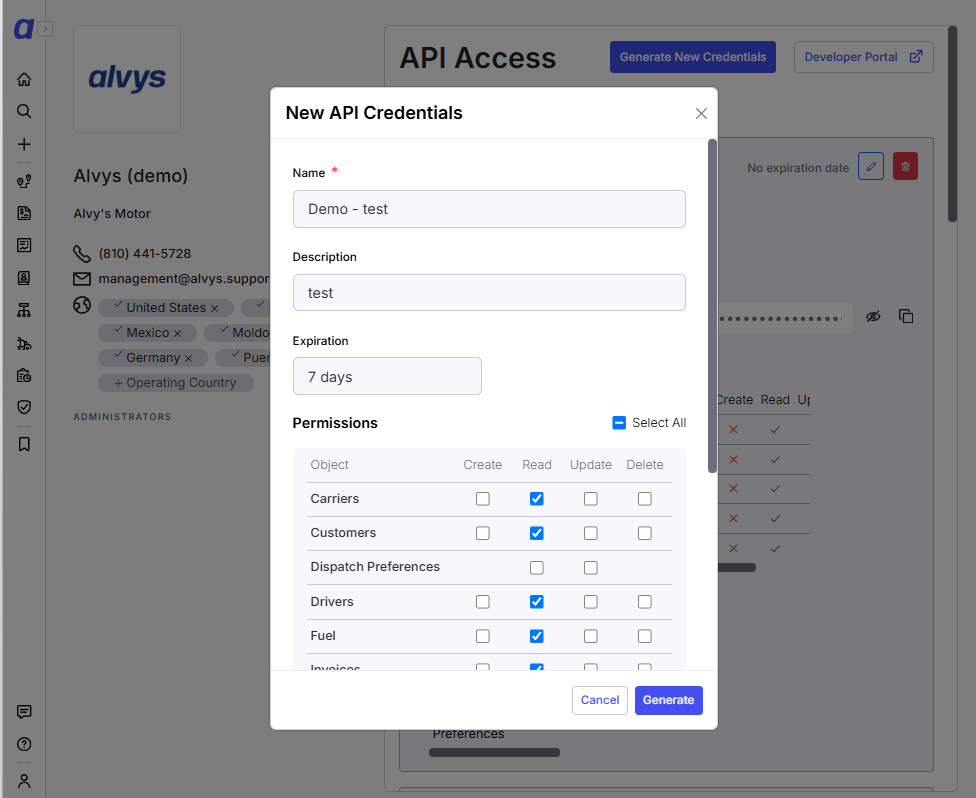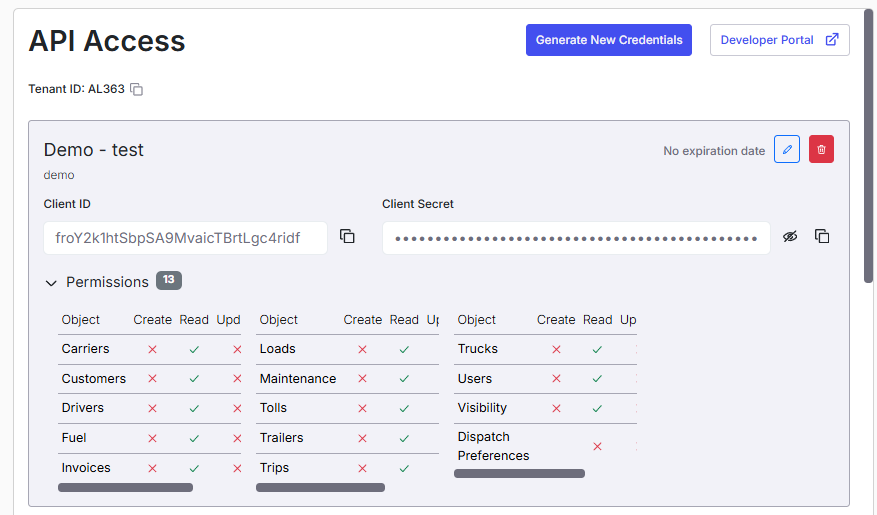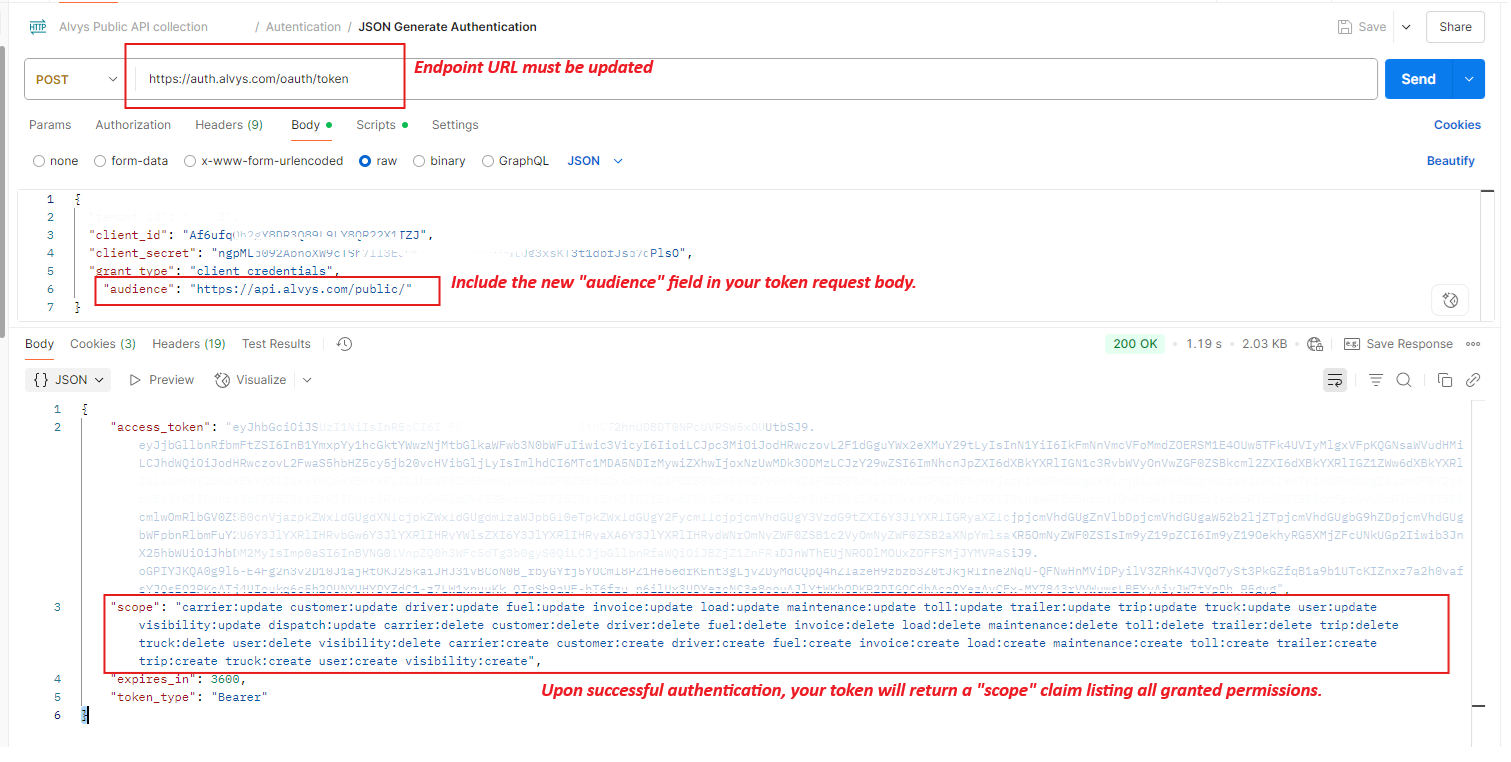Authentication
This page explains how to authenticate with the Alvys Public API using the OAuth 2.0 Client Credentials flow.
By leveraging OAuth 2.0, developers can empower their applications to seamlessly interact with Alvys' API on behalf of their users. This guide outlines the authentication process and provides detailed instructions on obtaining access tokens through direct application integration.
Getting API Access
- Existing Alvys customers can obtain API access by contacting their account representative.
- Independent Software Vendors (ISV) should contact the Alvys Partnership team.
🔐 Creating Client Application Credentials
Follow these steps to create your credentials in the Alvys Admin Portal:
-
Navigate to Admin → API Access
-
Click Create New Application
-
Fill out the Name and Description
-
Select your desired permissions (scopes)
-
Set an optional expiration date for the credentials
-
Click Generate

After creation, your Client ID and Client Secret will be shown, along with the scopes included for token generation. Customers can generate up to 10 sets of client credentials, but only newly generated ones can be edited.
These values are sensitive and must be stored securely—avoid sharing them publicly or exposing them in front-end code.

These credentials are used to request an access token via the issue token endpoint.
Construct Authorization Request
Construct a URL with the following parameters in the request body:
client_id: The unique identifier assigned to your application by Alvys.client_secret: The confidential token provided by Alvys upon application registration.audience: Must be"https://api.alvys.com/public/".grant_type: The type of grant flow to use. Must beclient_credentials
🔐 New Token Endpoint
All new token requests must now use the following endpoint:
Token URL
https://auth.alvys.com/oauth/token
Request Body (JSON)
{
"client_id": "YOUR_CLIENT_ID",
"client_secret": "YOUR_CLIENT_SECRET",
"audience": "https://api.alvys.com/public/",
"grant_type": "client_credentials"
}
When including a "scope" field in the token request body, please note:
- The returned token will always include all scopes that have been granted to your client application, regardless of what you specify in the scope field.
- Therefore, including a
scopefield in the request does not override or limit the access defined by your assigned permissions in the issued token.- The only functional effect of providing a
scopefield is that the token request will fail (unauthorized) if you include any scope that has not been granted to your client.- If the
scopefield is omitted, the token will still include all scopes granted to your application.
Either format may be used (JSON or Form-Encoded) ; both will return the same token and enforce scopes identically.
Curl JSON Content-Type Example
curl --request POST \
--url 'https://auth.alvys.com/oauth/token' \
--header 'Content-Type: application/json' \
--data '{
"client_id": "YOUR_CLIENT_ID",
"client_secret": "YOUR_CLIENT_SECRET",
"audience": "https://api.alvys.com/public/",
"grant_type": "client_credentials"
}'
Curl Form-Encoded Format Example
curl --request POST \
--url https://auth.alvys.com/oauth/token \
--header 'Content-Type: application/x-www-form-urlencoded' \
--data 'client_id=YOUR_CLIENT_ID' \
--data 'client_secret=YOUR_CLIENT_SECRET' \
--data 'audience=https://api.alvys.com/public/' \
--data 'grant_type=client_credentials'
The token you receive will include a scope claim (e.g. "load:read trip:create"), and our Public API enforces those scopes on every request. Use the resulting access token in your API request headers:
Authorization: Bearer YOUR_ACCESS_TOKEN
The
client_idand `client_secret are created in the Alvys Admin Portal under API Access.
Postman Token Request Example:

Each client credential’s token is restricted to the exact scopes you assign, ensuring it can only access those corresponding API endpoints.
NoteWhile you can assign
create,update, anddeletescopes and your token will include them, the corresponding write endpoints are not yet available. At this time, the Public API only exposes read operations—those additional scopes are in place for seamless adoption once write functionality is release
🔒 Scope Claim
Important: Legacy tokens generated through the previous /api/authentication/{tenant_id}/token authentication flow do not include the scope claim. These tokens will temporarily remain valid and behave as if all read-only scopes are granted, but this is only supported during the transition period. All clients must migrate to the new flow by July 31, 2025 to avoid disruption.
New tokens now follow a fine-grained permissions model, ensuring each application only has access to the specific API features it was granted.
Example:
"scope": "load:read driver:create"
Scopes control access to API endpoints and must be selected when creating your application in the Admin Portal.
Available Scopes
| Entity | Permission | Description |
|---|---|---|
| Customers | customer:read | View customer records |
| Customers | customer:create | Add a customer |
| Customers | customer:update | Edit customer details |
| Customers | customer:delete | Remove a customer |
| Drivers | driver:read | View driver profiles |
| Drivers | driver:create | Add new driver |
| Drivers | driver:update | Edit driver info |
| Drivers | driver:delete | Remove a driver |
| Fuel | fuel:read | View fuel records |
| Fuel | fuel:create | Add fuel transaction |
| Fuel | fuel:update | Update fuel entry |
| Fuel | fuel:delete | Delete fuel record |
| Invoices | invoice:read | View invoices |
| Invoices | invoice:create | Create invoice |
| Invoices | invoice:update | Edit invoice |
| Invoices | invoice:delete | Delete invoice |
| Loads | load:read | Retrieve load info |
| Loads | load:create | Create a load |
| Loads | load:update | Update a load |
| Loads | load:delete | Delete a load |
| Maintenance | maintenance:read | View maintenance data |
| Maintenance | maintenance:create | Log maintenance event |
| Maintenance | maintenance:update | Edit maintenance record |
| Maintenance | maintenance:delete | Remove maintenance record |
| Tolls | toll:read | View toll data |
| Tolls | toll:create | Log toll |
| Tolls | toll:update | Update toll entry |
| Tolls | toll:delete | Delete toll entry |
| Trailers | trailer:read | View trailer info |
| Trailers | trailer:create | Register trailer |
| Trailers | trailer:update | Edit trailer record |
| Trailers | trailer:delete | Remove trailer |
| Trips | trip:read | View trip details |
| Trips | trip:create | Create trip |
| Trips | trip:update | Update trip |
| Trips | trip:delete | Cancel/delete trip |
| Trucks | truck:read | View truck info |
| Trucks | truck:create | Register truck |
| Trucks | truck:update | Update truck record |
| Trucks | truck:delete | Remove truck |
| Users | user:read | View users |
| Users | user:create | Add new user |
| Users | user:update | Modify user |
| Users | user:delete | Remove user |
| Visibility | visibility:read | Access tracking data |
| Visibility | visibility:create | Trigger visibility update |
| Visibility | visibility:update | Modify visibility data |
| Visibility | visibility:delete | Remove tracking entry |
| Dispatch Preferences | dispatch:read | View dispatch rules |
| Dispatch Preferences | dispatch:update | Update dispatch preferences |
| Carriers | carrier:read | View carrier profiles |
| Carriers | carrier:create | Add a new carrier |
| Carriers | carrier:update | Update carrier details |
| Carriers | carrier:delete | Remove a carrier from records |
🧪 Troubleshooting
- ✅ Double-check your
client_id,client_secret, andaudience - ✅ Ensure scopes are correctly assigned in API Access- Admin Portal
- ✅ Validate that the client is active and not expired
- ✅ Use only supported content types:
application/jsonorapplication/x-www-form-urlencoded - For technical support: [email protected]
Updated 3 months ago